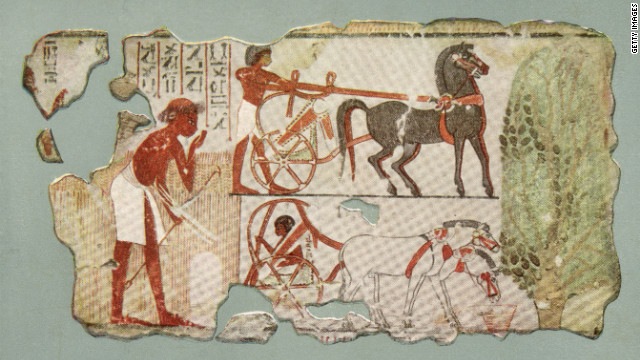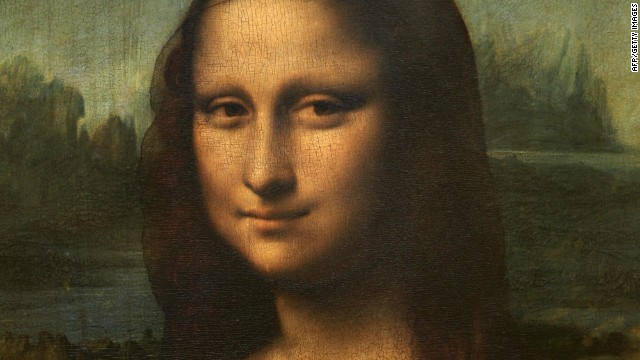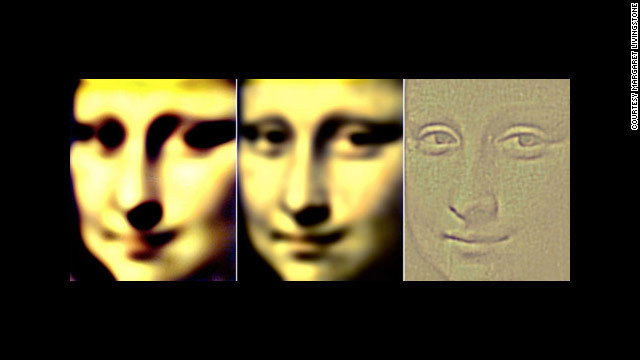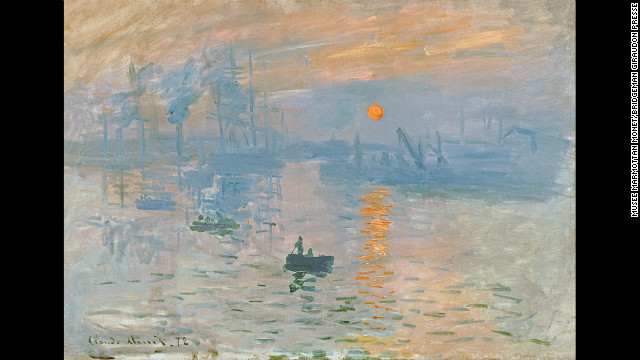
In Spain's Tito Bustillo Cave, scientists found these horse paintings overlaying older red paintings, which could be 29,000 years or older.

This Egyptian wall painting, from 1350 BC, is an example of how artists have long been drawing outlines around figures of people and animals.

Leonardo da Vinci took advantage of the differences in the human central and peripheral visual systems to create a dynamic smile in the "Mona Lisa."

This is a simulation by Margaret Livingstone of what you perceive when you view
the "Mona Lisa" in your peripheral vision, on the left and middle, and straight-on. Note how the smile changes.

Pablo Picasso's "Les Demoiselles d'Avignon" from 1907 may be especially pleasing to the eye because it exaggerates human forms, showing influences of the cubism movement

Semir Zeki, professor of neuroesthetics at University College London, created this sculpture "Squaring the Circle." Projecting colored lights on the hanging object creates the illusion of depth.

Impressionistic portraits such as this by Pierre-Auguste Renoir may be have particular emotional appeal because of the blurriness or patchiness of the face. Research has shown that blurry images may connect more directly with the emotional centers of the brain than normal ones.

In "Impression Sunrise" by Claude Monet, circa 1873, the artist makes the sun look
unusually bright by choosing an orange with the same luminance as the background, says Margaret Livingstone of Harvard University
Pablo Picasso once said,
"We all know that Art is not truth. Art is a lie that makes us realize
truth, at least the truth that is given us to understand. The artist
must know the manner whereby to convince others of the truthfulness of
his lies."
If we didn't buy in to
the "lie" of art, there would obviously be no galleries or exhibitions,
no art history textbooks or curators; there would not have been cave
paintings or Egyptian statues or Picasso himself. Yet, we seem to agree
as a species that it's possible to recognize familiar things in art and
that art can be pleasing.
To explain why, look no further than the brain.
The human brain is wired
in such a way that we can make sense of lines, colors and patterns on a
flat canvas. Artists throughout human history have figured out ways to
create illusions such as depth and brightness that aren't actually there
but make works of art seem somehow more real.
And while individual
tastes are varied and have cultural influences, the brain also seems to
respond especially strongly to certain artistic conventions that mimic
what we see in nature.
What we recognize in art
It goes without saying
that most paintings and drawings are, from an objective standpoint,
two-dimensional. Yet our minds know immediately if there's a clear
representation of familiar aspects of everyday life, such as people,
animals, plants, food or places. And several elements of art that we
take for granted trick our brains into interpreting meaning from the
arbitrary.
Lines
For instance, when you
look around the room in which you're sitting, there are no black lines
outlining all of the objects in your view; yet, if someone were to
present you with a line-drawing of your surroundings, you would probably
be able to identify it.
This concept of line
drawings probably dates back to a human ancestor tracing lines in the
sand and realizing that they resembled an animal, said Patrick Cavanagh, professor at Universite Paris Descartes.
"For science, we're just
fascinated by this process: Why things that are not real, like lines,
would have that effect," Cavanagh said. "Artists do the discoveries, and
we figure out why those tricks work."
That a line drawing of a
face can be recognized as a face is not specific to any culture.
Infants and monkeys can do it. Stone Age peoples did line drawings; the
Egyptians outlined their figures, too.
It turns out that these
outlines tap into the same neural processes as the edges of objects that
we observe in the real world. The individual cells in the visual system
that pick out light-dark edges also happen to respond to lines,
Cavanagh said. We'll never know who was the first person to create the
first "sketch," but he or she opened the avenue to our entire visual
culture.
Faces
This brings us to
modern-day emoticons; everyone can agree that this :-) is a sideways
happy face, even though it doesn't look like any particular person and
has only the bare minimum of facial features. Our brains have a special
affinity for faces and for finding representations of them (some say
they see the man in the moon, for instance). Even infants have been
shown in several studies to prefer face-like patterns over patterns that
don't resemble anything.
That makes sense from an
evolutionary perspective: It benefits babies to establish a bond with
their caregivers early on, notes Mark H. Johnson in a 2001 Nature Reviews Neuroscience article.
Our primitive human
ancestors needed to be attuned to animals around them; those who were
most aware of potential predators would have been more likely to survive
and pass on their genes.
So our brains readily
find faces in art, including in Impressionist paintings where faces are
constructed from colored lines or discrete patches of color. This
"coarse information" can trigger emotional responses, even without you
bearing aware of it, Cavanagh and David Melcher write in the essay
"Pictorial Cues in Art and in Visual Perception."
Patrik Vuilleumier at
the University of Geneva and colleagues figured out that the amygdala, a
part of the brain involved in emotions and the "flight or fight
response," responds more to blurry photos of faces depicting fear than
unaltered or sharply detailed images. At the same time, the part of our
brain that recognizes faces is less engaged when the face is blurry.
Cavanagh explains that
this may mean we are more emotionally engaged when the detail-oriented
part of our visual system is distracted, such as in Impressionist works
where faces are unrealistically colorful or patchy.
Color vs. luminance
Artists also play with the difference between color and luminance.
Most people have three
kinds of cones in the eye's retina: red, blue and green. You know what
color you're looking at because your brain compares the activities in
two or three cones. A different phenomenon, called luminance, adds the
activities from the cones together as a measure of how much light
appears to be passing through a given area.
Usually when there is color contrast, there is also luminance contrast, but not always. In the research of Margaret Livingstone,
professor of neurobiology at Harvard University, she explored the
painting "Impression Sunrise" by Claude Monet, which features a
shimmering sun over water. Although the orange sun appears bright, it
objectively has the same luminance as the background, Livingstone found.
So why does it look so bright to the human eye?
Livingstone explained in
a 2009 lecture at the University of Michigan that there are two major
processing streams for our visual system, which Livingstone calls the
"what" and "where" streams. The "what" allows us to see in color and
recognize faces and objects. The "where" is a faster and less
detail-oriented but helps us navigate our environment but is insensitive
to color.
When our brains
recognize a color contrast but no light contrast, that's called "equal
luminance," and it creates a sort of shimmering quality, Livingstone
said. And that's what's going on in a Monet painting.
Artists often play with
luminance in order to give the illusion of three dimensions, since the
range of luminance in real life is far greater than what can be
portrayed in a painting, Livingstone said. By placing shadows and lights
that wouldn't be present in real life, paintings are able to trick the
eye into perceiving depth.
For instance, medieval
paintings portrayed the Virgin Mary in a dark blue dress, which makes
her look flat. Leonardo da Vinci, however, revolutionized her appearance
by adding extra lights to contrast with darks.
The bottom line: To
trick the brain into thinking something looks three-dimensional and
lifelike, artists add elements -- lightness and shadows -- that wouldn't
be present in real life but that tap into our hard-wired visual
sensibilities.
Mona Lisa's smile
The Mona Lisa is undoubtedly one of the world's most famous paintings; the face of the woman in the painting is iconic.
Da Vinci gave her facial
expression a dynamic quality by playing with a discrepancy that exists
in our peripheral and central vision systems, Livingstone says.
The human visual system
is organized such that the center of gaze is specialized for small,
detailed things, and the peripheral vision has a lower resolution --
it's better at big, blurry things.
That's why, as your eyes
move around the Mona Lisa's face, her expression appears to change,
Livingstone says. The woman was painted such that, looking directly at
the mouth, she appears to smile less than when you're staring into her
eyes. When you look away from the mouth, your peripheral visual system
picks up shadows from her cheeks that appear to extend the smile.
Photomosaics also take
advantage of this difference between visual systems: With your
peripheral visual system you might see a picture of a cat that's
composed of individual photos of cats that are completely different.
Shadows and mirrors
From a scientific
standpoint, it's possible to determine exactly how shadows are supposed
to look based on the placements of light and how mirror reflections
appear at given angles. But the brain doesn't perform such calculations
naturally.
It turns out that we
don't really notice when shadows in paintings are unrealistically
placed, unless glaringly so, or when mirrors don't work exactly the way
they do in real life, Cavanagh explained in a 2005 article in "Nature."
Shadows are colored more
darkly than what's around them; it's not readily apparent if the
lighting direction is inconsistent. They can even be the wrong shape; as
long as they don't look opaque, they help convince us of a
three-dimensional figure.
Studies have shown that
people don't generally have a good working knowledge of how reflections
should appear, or where, in relation to the original object, Cavanagh
said. Paintings with people looking into mirrors or birds reflected in
ponds have been fooling us for centuries.
Why we like art
There are certain
aspects of art that seem universally appealing, regardless of the
environment or culture in which you grew up, argues V.S. Ramachandran,
a neuroscientist at the University of California, San Diego. He
discusses these ideas in his recent book "The Tell Tale Brain."
Symmetry, for instance,
is widely considered to be beautiful. There's an evolutionary reason for
that, he says: In the natural world, anything symmetrical is usually
alive. Animals, for instance, have symmetrical shapes.
That we find symmetry
artistically appealing is probably based on a hard-wired system meant to
alert us to the possibility of a living thing, he said.
And then there's what
Ramachandran calls the "peak shift principle." The basic idea is that
animals attracted to a particular shape will be even more attracted to
an exaggerated version of that form.
This was shown in an
experiment by Niko Tinbergen involving Herring seagull chicks. In a
natural environment, the chick recognizes its mother by her beak. Mommy
seagull beaks are yellow with a red spot at the end. So if you wave an
isolated beak in front of a chick, it believes the disembodied beak is
the mother and taps it as a way of asking to be fed.
But even more striking,
if you have a long yellow stick with a red stripe on it, the chick still
begs for food. The red spot is the trigger that tells the chick this is
the mother who will feed it. Now here's the crazy part: the chick is
even more excited if the stick has multiple red stripes.
The point of the seagull
experiment is that although the actual mother's beak is attractive to
the chick, a "super beak" that exaggerates the original beak
hyperactivates a neural system.
"I think you're seeing
the same thing with all kinds of abstract art," Ramachandran said. "It
looks distorted to the eye, but pleasing to the emotional center to the
brain."
In other words, the
distorted faces of famous artists such as Pablo Picasso and Gustav Klimt
may be hyperactivating our neurons and drawing us in, so to speak.
Impressionism, with its soft brushstrokes, is another form of distortion
of familiar human and natural forms.
Further research: Can we know what is art?
There's now a whole
field called neuroesthetics devoted to the neural basis of why and how
people appreciate art and music and what is beauty.
Semir Zeki at University College London
is credited with establishing this discipline, and says it's
mushrooming. Many scientists who study emotion are collaborating in this
area. Zeki is studying why people tend prefer certain patterns of
moving dots to others.
Stanford Journal of Neuroscience: The Neuroscience of Art
There have been several criticisms about neuroesthetics as a field. Philosopher Alva Noe wrote in The New York Times last year
that this branch of science has not produced any interesting or
surprising insights, and that perhaps it won't because of the very
nature of art itself -- how can anyone ever say definitively what it is?
Zeki said many
challenges against his field are based on the false assumption that he
and colleagues are trying to explain works of art.
"We're not trying to explain any work of art," he said. "We're trying to use works of art to understand the brain."
Neuroscientists can make art, too.
Zeki had works in an
exhibit that opened last year in Italy called "White on White: Beyond
Malevich." The series included white painted sculptures on white walls,
illuminated by white light and color projections. With red and white
light, the shadow of the object appears in the complimentary color --
green -- and the shadows change as your angle of vision changes.
The biological basis for
this complimentary color effect is not well understood, nor is the
depth of shadow, which is also an illusion.
So was Picasso right -- is art a lie? The description of Zeki's exhibition in Italy may highlight the truth:
"Our purpose is to show how the brain reality even overrides the objective reality."
 In Spain's Tito Bustillo Cave, scientists found these horse paintings overlaying older red paintings, which could be 29,000 years or older.
In Spain's Tito Bustillo Cave, scientists found these horse paintings overlaying older red paintings, which could be 29,000 years or older.
 This Egyptian wall painting, from 1350 BC, is an example of how artists have long been drawing outlines around figures of people and animals.
This Egyptian wall painting, from 1350 BC, is an example of how artists have long been drawing outlines around figures of people and animals.
 Leonardo da Vinci took advantage of the differences in the human central and peripheral visual systems to create a dynamic smile in the "Mona Lisa."
Leonardo da Vinci took advantage of the differences in the human central and peripheral visual systems to create a dynamic smile in the "Mona Lisa."
 This is a simulation by Margaret Livingstone of what you perceive when you view
the "Mona Lisa" in your peripheral vision, on the left and middle, and straight-on. Note how the smile changes.
This is a simulation by Margaret Livingstone of what you perceive when you view
the "Mona Lisa" in your peripheral vision, on the left and middle, and straight-on. Note how the smile changes.
 Pablo Picasso's "Les Demoiselles d'Avignon" from 1907 may be especially pleasing to the eye because it exaggerates human forms, showing influences of the cubism movement
Pablo Picasso's "Les Demoiselles d'Avignon" from 1907 may be especially pleasing to the eye because it exaggerates human forms, showing influences of the cubism movement
 Semir Zeki, professor of neuroesthetics at University College London, created this sculpture "Squaring the Circle." Projecting colored lights on the hanging object creates the illusion of depth.
Semir Zeki, professor of neuroesthetics at University College London, created this sculpture "Squaring the Circle." Projecting colored lights on the hanging object creates the illusion of depth. Impressionistic portraits such as this by Pierre-Auguste Renoir may be have particular emotional appeal because of the blurriness or patchiness of the face. Research has shown that blurry images may connect more directly with the emotional centers of the brain than normal ones.
Impressionistic portraits such as this by Pierre-Auguste Renoir may be have particular emotional appeal because of the blurriness or patchiness of the face. Research has shown that blurry images may connect more directly with the emotional centers of the brain than normal ones. 